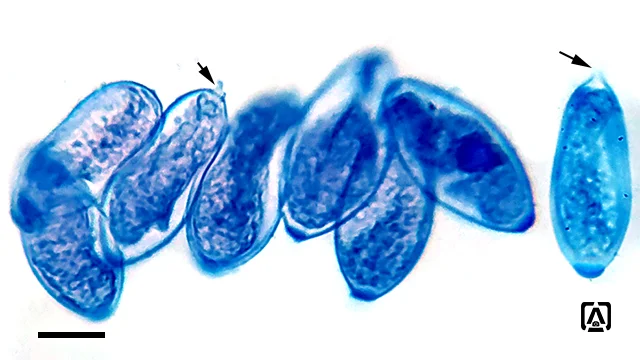Leaf Blight of Taro
Host: Taro, Arvi (Colocasia esculenta)
Pathogen: Phytophthora colocasiae Racib
Pathogen: Phytophthora colocasiae Racib
Distribution
Taro leaf blight was first reported and described by Raciborski in 1900. Since then the disease has been reported from to occur in South-East Asia, Indonesia, China, India, Philippines, Malaysia, Hawaii, Papua New Guinea, British Solomon Islands and the Trust Territories of the Pacific. Taro leaf blight can cause up to 50 % loss in yield. In India the disease is prevalent in northern and eastern part, where the crop is chiefly grown.
Symptoms
Early symptoms appear as water-soaked, brown, circular lesions on the leaf. As the lesion matures, it become dark brown with yellow margins. Around the lesion white mycelium appear, which can be seen with naked eyes. Symptoms is characterized by yellow to red characteristic fluid oozing from the center of the spot. Infection occur more in the area, where water accumulates.
 |
| Taro leaves showing characteristic blight symptoms |
Pathogen
Blight of taro is caused by Phytophthora colocasiae Racib. Pathogen grow optimum at temperature range between 27 - 30°C. It produces semipappilate sporangium with a medium pedicel. Sporangia are caducous and easily detached from the pedicel. Sporangia are ellipsoid to ovoid, measuring between 17–28 × 40–70 µm. They have conspicuous basal plug at the base of sporangium at the attachment of sporangiophore. The length:breath ratio of sporangium is 1.6 to 2.6.
 |
| Sporangia of Phytophthora colocasiae showing apical papilla (arrow) and basal plug. bar = 20 µm |
Control measures
- Aggarwal and Mehrotra (1987) reported excellent control of the disease by application of Demosan 65W and Difolatan 80W.
- Crop rotation should be practiced to avoid the disease incidence.
- Crop should be regularily checked. On appearance of early symptom, leaf should be cut and removed away from field. If allowed, it should be burt.
References
- Aggarwal, A., Mehrotra, R.S. Control of phytophthora leaf blight of taro (Colocasia esculenta) by fungicides and roguing. Phytoparasitica 15, 299–305 (1987). https://doi.org/10.1007/BF02979545.
Content first created on 11-06-2023
last updated on 11-06-2023
last updated on 11-06-2023

